The threat of Annihilation just gets bigger and bigger
By Graig
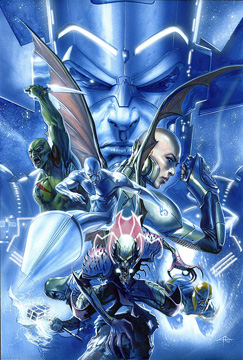 After the climactic and cool finales to the Annihilation prologue mini-series featuring the Silver Surfer and Nova (the Ronan and Super-Skrull minis didn’t sell me past their first issues), Keith Giffen was going to have to step up his game to keep the Annihilation mini-series as epic and exciting as what came before. Well, by and large, he has succeeded.
After the climactic and cool finales to the Annihilation prologue mini-series featuring the Silver Surfer and Nova (the Ronan and Super-Skrull minis didn’t sell me past their first issues), Keith Giffen was going to have to step up his game to keep the Annihilation mini-series as epic and exciting as what came before. Well, by and large, he has succeeded.
Annihilation #1 kicks off six months after the events of the prologue minis, and drops the reader hip-deep into the middle of a battlefield. The war against Annihilus and his seemingly endless army of insectoid drones still rages across the galaxy, the resistance becoming more adept at fighting the enemy, but still losing ground. In the intervening months, a now battle hardened Richard Ryder, aka the last Nova, has become Commander-in-Chief of the resistance, and is now more like Nick Fury in a dorky helmet, rather than just some dork in a dorky helmet.
For those that skipped all the prologue materials (for shame), Annihilus, ruler of the Negative Zone, felt “our” universe expanding into his, so now he and his “annihilation wave” have come to take back what was lost, with interest. In the process so far, the wave has destroyed, amongst others, the Nova Corps and its homeworld of Xandar, obliterated the Skrull empire, decimated the Kree, and destroyed the ancient prison system, the Kyln. The latter is most important, since the Kyln housed some of the galaxy’s most dangerous individuals, including two beings named Aegis and Tenebrous, both of whom were imprisoned by Galactus and are now free, aligned with Annihilus, and ready to reap vengeance on the world-devourer.
As far as space battles go, Giffen certainly understands what has made some galactic war stories successful and others not so. Using characters generally forgotten or at the very least ignored, he has established a high threat level and an anything-can-happen story, and he’s brought it all together in such a way that isn’t just superheroes saving the day, but a tangible “us” versus “them” war where every soldier has his or her place.
Andrea DiVito did a wonderful job on the early issues of the short-lived Thing series, and takes on a much different challenge here. He handles it admirably, his style not too showy as to overtake the story, but not too mundane as to be uninteresting. His storytelling chops are more than capable and he draws one of the best Galactus’ since Kirby himself. Of course, DiVito’s secret weapon here, as on the Thing, is colorist Laura Villari, whose earthy palette creates a gritty aesthetic but allows the more cosmic elements like force fields and cosmic energy pop off the page in contrast.
It’s been some time since the last exciting space war in comics, but this one both looks and reads good and is ever so engaging.
RATING: 
Mouse Guard #4: More of What Is Definitely Not the Same
By
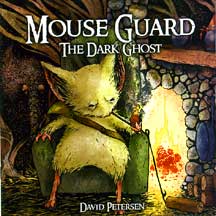 A great sameness presently hangs over much of the comics industry, to the detriment of both itself and its patrons. Some blame is rightly attributed to the producers, who not only seek the easy route, but have little stomach for the financial risk involved in stretching beyond the normal limits. The tremendous success of the superhero films in the past decade has further encouraged the bookkeepers to push the trend of costumed adventurers, not just into the forefront, but almost to the exclusion of all other genres. The readers must also accept their share of the blame when they shun the westerns, crime, romance, and other non-superhero books. To be completely fair, many of the most recent efforts have been poor, and that is a charitable assessment. However, there is an exception.
A great sameness presently hangs over much of the comics industry, to the detriment of both itself and its patrons. Some blame is rightly attributed to the producers, who not only seek the easy route, but have little stomach for the financial risk involved in stretching beyond the normal limits. The tremendous success of the superhero films in the past decade has further encouraged the bookkeepers to push the trend of costumed adventurers, not just into the forefront, but almost to the exclusion of all other genres. The readers must also accept their share of the blame when they shun the westerns, crime, romance, and other non-superhero books. To be completely fair, many of the most recent efforts have been poor, and that is a charitable assessment. However, there is an exception.
In the tradition of Wind In The Willows and Watership Down, David Petersen has created a world that is anthropomorphic but in such a believable manner that the central characters, despite being "lower forms of life," are readily accepted as villains and heroes. In Petersen’s world, the mice lead a medieval life, with guards, villages, epic adventures, and a history to follow. Humans are unseen and unmissed. No capes and no gamma radiation. Just good storytelling and good art.
If this series has a failing it is the division of the story into six parts. Like many of the limited series published in the past decade, it calls out for trade paperback status. In fact, the fan cannot help but wonder why it is not being released as a unit and sold in the more traditional children’s bookstore. Despite its complete suitability for the adult market, artwork of this quality is certainly a candidate for a Caldecott Medal. The Caldecott Medal was named in honor of nineteenth-century English illustrator Randolph Caldecott. It is awarded annually by the Association for Library Service to Children, a division of the American Library Association, to the artist of the most distinguished American picture book for children. While scenes of brutality may be a bit much for some children, the quality of this work cannot be denied and deserves a wider audience.
RATING: 
![]()

The Great Catsby Vol. 2
(Net Comics)
By Mark Wheaton
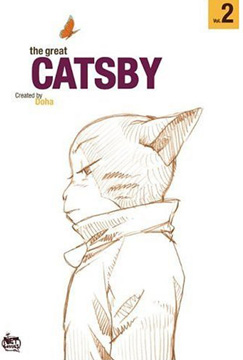 Great anthropomorphic animal comics are getting easier and easier to find, particularly with the arrival of the great “Blacksad,” “Hipflask,” “Mouse Guard,” and especially the oft-cryptic work of Jason. But sometimes it’s done in such an interesting and original way that it’s as if there are very few other competitors on the playing field. The Korean book “The Great Catsby” by writer/artist
Great anthropomorphic animal comics are getting easier and easier to find, particularly with the arrival of the great “Blacksad,” “Hipflask,” “Mouse Guard,” and especially the oft-cryptic work of Jason. But sometimes it’s done in such an interesting and original way that it’s as if there are very few other competitors on the playing field. The Korean book “The Great Catsby” by writer/artist
While you might imagine this to be some sort of comical adaptation of the classic Fitzgerald novel, it’s far more than that – taking on the themes of the novel: infidelity, lust, jealousy, love, class difference (even the punch to Myrtle’s nose is mirrored), etc., but in an incredibly original new framework among the lower class neighborhoods of Seoul. The detailed locations presented here are that much more interesting when complimented by the series of reference photographs at the end of the book showing just how true-to-life Doha’s art really is.
The story follows poor, just-out-of-university Catsby who shares an apartment with the already-employed Houndu (one of the only non-cats in the book) as they tackle issues of life and love. Catsby has found it with an over-perky, easily excited kitten named Sun who satisfies him most of the time, but her silly disposition sometimes gets in the way of making Catsby fully commit. Houndu, for his part, finds himself at the brink of an affair with the married mother of one of his students – something he finds tempting until the woman’s unknowing husband offers him money to become a “night husband” to his wife to prevent her from straying too far.
The plot is interesting (and one that sometimes feels like a distant cousin to “Scott Pilgrim”), but the way the characters are laid out and how the story is actually told make it something special. There are plenty of tangents between Catsby and Houndu (as well as Catsby and Sun) that reveal Doha’s (and, well, the translator’s) real strength for dialogue. But then a great deal of body language revealed in the art gives the characters just so much more. Whether it be the way Houndu winks or the subtle pain Sun feels as she makes Catsby tell her about a previous relationship, the marriage of the art to the characterization is very strong – giving everyone involved that many more layers.
Apparently, there are four volumes of “The Great Catsby” to be published this year with Vol. 2 just making it to my comic shop this week, Vol. 3 due in September and Vol. 4 coming in December.. This is definitely one of the most interesting books of ’06 – a series that has already won a number of awards overseas – and will likely win many fans stateside.
RATING: 
X-Statix Presents: Dead Girl TPB
Marvel Knights
By Graig Kent
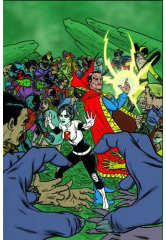 I find the title of this book very interesting, as I never thought Dead Girl to be one of the more popular characters on the X-Statix team, nor did I think the X-Statix to be, really, all that popular themselves. When the series faded to black, I thought that it was curtains for Pete Milligan and Mike Allred’s team of bickering, media savvy, self-obsessed, highly death-prone superheroes, since they weren’t at all your prototypical classic Marvel superheroes and, although the series was sharply written and highly entertaining, the individual characters were pretty forgettable. So the return of the X-Statix, while exciting, was also unexpected… and to focus on Dead Girl? Really?
I find the title of this book very interesting, as I never thought Dead Girl to be one of the more popular characters on the X-Statix team, nor did I think the X-Statix to be, really, all that popular themselves. When the series faded to black, I thought that it was curtains for Pete Milligan and Mike Allred’s team of bickering, media savvy, self-obsessed, highly death-prone superheroes, since they weren’t at all your prototypical classic Marvel superheroes and, although the series was sharply written and highly entertaining, the individual characters were pretty forgettable. So the return of the X-Statix, while exciting, was also unexpected… and to focus on Dead Girl? Really?
Okay, not really. X-Statix Presents: Dead Girl is actually a Dr. Strange story, which is why it perplexes me that the title ignores him completely. His cache must be in pretty bad shape if Dead Girl is a bigger attraction than he.
Anyway, the book is a fabulous tale that finds five dead Marvel characters of yore (X-Statix member Tyke Alicar, Mysterio, Kraven the Hunter, Miss Liberty and the more-mysterious-than-Mysterio Pitiful One) finding a substance in the Netherworld that allows them to return to Earth for 24-hour periods. Their goal is to wreak havoc and destruction in hopes that they can blackmail Dr. Strange into returning them to life. Strange doesn’t want to mess with the balances of the afterlife and undead, so he leaves his corporeal body and heads to the land of the dead, seeking Dead Girl’s assistance in ceasing the quintet’s intrusions into the living world. Assembling a totally rag-tag team of dead heroes (including Ant Man, the Phantom Rider, other dead X-Statix members and, naturally, the Piano Player) things don’t go very smoothly for Strange. Not only are his incurable hemorrhoids acting up, but the dead heroes aren’t exactly what one would call lucid, meaning he’s acting as much as babysitter as he is team leader.
Milligan has crafted a fine piece of comedy with this Dead Girl book, taking the piss out of Dr. Strange is always good fun, and it’s good to see him return to the characters he created, even if they are still mostly dead. The art is stellar, it’s practically indiscernible where Nick Dragotta stops and Mike Allred begins. It has that patented Allred four-color retro-pop style which always goes down well, and the colors by Laura Allred, even in the dullness of the underworld, still dazzle.
You don’t have to be an X-Statix fan to enjoy this book, which Milligan seems to have taken some pains to make it appealing to the X-Statix followers and a more general audience. It’s a romp-and-a-half regardless, and recommended.
RATING: 
Kickback
(Dark Horse)
By Mark Wheaton
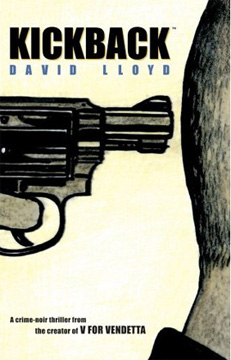 “You’re one of Zed’s boys. On the night he got his, you went into Mercy for a patch-up… You would have gone out of town to Zed’s quack, but you were spilling too much blood…”
“You’re one of Zed’s boys. On the night he got his, you went into Mercy for a patch-up… You would have gone out of town to Zed’s quack, but you were spilling too much blood…”
Emblazoned on the cover of Dark Horse’s graphic novel release “Kickback” is the legend, “A crime-noir thriller from the creator of ‘V for Vendetta.’” While that’s something of a half-truth, if what they want are perspective readers to think there’s a possibility something quite great waits inside, it’s dead on.
“Kickback” is an excellent, sometimes shocking, always brutal and somewhat morally ambiguous crime story in the finest James Ellroy tradition ***SPOILER WARNING*** as you’re following around a dirty cop named Joe Canelli that you don’t even know is dirty for the first half of the book or so. By then, you’ve been allowed to see that just about everyone is dirty and this tale is going to get worse before it gets better.
The book begins in Canelli’s mind as he walks a moral tightrope that turns out to be a memory from his childhood about nimbly navigating a narrow catwalk inside a blimp – something that’s coming to the fore now as his mental qualms about corruption get louder and louder. This is put to the test when – after a particularly violent attack on a gang during a drug deal that went bad – dirty cops all over the city are targeted for murder and Canelli has to figure out which side he’s on.
What a great set-up, huh? What takes this simple idea to the next level is the combination of Canelli’s characterization – which is pitch perfect, a complicated cop at a crossroads – and Lloyd’s fantastic choices for the art. While the panels themselves are beautifully rendered, Lloyd’s decisions when to cut in and out of a scene – like a truly masterful film director – let the story play out in a really cool way. Similarly, the angles into the action in panel after panel belie the same sensitivity – just show enough, keep it subtle.
Originally published as a two-parter in France, “Kickback” proves that Lloyd is actually far more than the “illustrator of ‘V for Vendetta’” – certainly not the worst appellation one can have, but one an artist might be sick of after 20+ years of great collaborations between the likes of Grant Morrison, Garth Ennis, Warren Ellis and James Delano. At a time where finding a good new crime thriller at the book story is getting kind of difficult, to say nothing of at the movie theater or on television, it’s nice to know one can always rely on the comic shop.
RATING: 
![]()

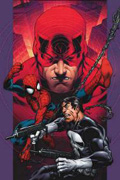 Ultimate Spider-Man Annual #2. (Marvel) Last year, Marvel revived the long-dormant tradition of summer comic annuals, with a bit of a twist—instead of one-shot out-of-continuity stories, Editor in Chief Joe Quesada said that Marvel would only do annuals that contributed in a significant way to the titles involved, and they delivered, with such developments as the death of the Ultimate universe’s Gambit and revelations of the darker side of Nick Fury. Arguably the biggest, and most well-received development was the romance between Spider-Man and Kitty Pryde of the X-Men, which carried over into the regular Ultimate Spider-Man title, and provided more than a few tense moments for Peter Parker and Mary Jane Watson. For this year’s Annual, writer Brian Bendis teams again with artist Mark Brooks (doing a first-rate impression of regular series artist Mark Bagley). Instead of the extended teen romance of last year’s Annual, this one’s the all-action issue, as a gang war lands Spider-Man in the midst of a showdown involving (among others) The Kingpin, The Punisher, Moon Knight, and Daredevil. The action may not be quite as down-and-dirty as David Finch’s in the current Moon Knight series, but it’s not far behind, as Brooks lays down page after page of fists and bullets flying. And in line with Quesada’s dictum, the story presents a death that will have an impact on the regular Ultimate Spider-Man book, as well as presaging the formation of a new team in the Ultimate universe. As issue #100 of Ultimate Spider-Man approaches, it’s nice to see the title back on its stride. – Jeb D.
Ultimate Spider-Man Annual #2. (Marvel) Last year, Marvel revived the long-dormant tradition of summer comic annuals, with a bit of a twist—instead of one-shot out-of-continuity stories, Editor in Chief Joe Quesada said that Marvel would only do annuals that contributed in a significant way to the titles involved, and they delivered, with such developments as the death of the Ultimate universe’s Gambit and revelations of the darker side of Nick Fury. Arguably the biggest, and most well-received development was the romance between Spider-Man and Kitty Pryde of the X-Men, which carried over into the regular Ultimate Spider-Man title, and provided more than a few tense moments for Peter Parker and Mary Jane Watson. For this year’s Annual, writer Brian Bendis teams again with artist Mark Brooks (doing a first-rate impression of regular series artist Mark Bagley). Instead of the extended teen romance of last year’s Annual, this one’s the all-action issue, as a gang war lands Spider-Man in the midst of a showdown involving (among others) The Kingpin, The Punisher, Moon Knight, and Daredevil. The action may not be quite as down-and-dirty as David Finch’s in the current Moon Knight series, but it’s not far behind, as Brooks lays down page after page of fists and bullets flying. And in line with Quesada’s dictum, the story presents a death that will have an impact on the regular Ultimate Spider-Man book, as well as presaging the formation of a new team in the Ultimate universe. As issue #100 of Ultimate Spider-Man approaches, it’s nice to see the title back on its stride. – Jeb D.
RATING: 
 Absolute Kingdom Come (DC Comics) – An imaginative story of the DC pantheon that places them in a more "realistic" light, as told by one of comicdom’s better writers, illustrated by one of the better illustrators in the comic’s industry, and produced in its most complete form. While many of the "imaginary" stories produced over the years have left a great deal to be desired, this is one of the best. If you loved the plot and artwork, you will never get a better compilation of the work that went into it, nor a higher quality printing of the work. If you missed the story the first time it came around, and the trade paperback, and the limited edition slipcased hardback version, and the novelized version, you might want to rush right out to your local online book dealer and pick this up. – Elgin
Absolute Kingdom Come (DC Comics) – An imaginative story of the DC pantheon that places them in a more "realistic" light, as told by one of comicdom’s better writers, illustrated by one of the better illustrators in the comic’s industry, and produced in its most complete form. While many of the "imaginary" stories produced over the years have left a great deal to be desired, this is one of the best. If you loved the plot and artwork, you will never get a better compilation of the work that went into it, nor a higher quality printing of the work. If you missed the story the first time it came around, and the trade paperback, and the limited edition slipcased hardback version, and the novelized version, you might want to rush right out to your local online book dealer and pick this up. – Elgin
RATING: 
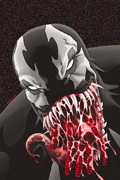 Beyond #2 (Marvel) – I had an idea where Dwayne McDuffie was going with this series, since last issue’s rather generic heroes-versus-villains-fight-to-the-death-for-their-heart’s-desire set-up, while sharply written, seemed pretty by the numbers. But with this second issue, things take a different turn, as the flying space arena the assembly of heroes and villains were aboard crash lands on an unknown planet, and the group forgets about Venom for the sake of self-preservation. They encounter Michael, the gravedigger from the first issue, and he further expands upon the set-up of the series, but, well, when the Dragon Man attacks everything else gets pushed to the side. McDuffie, with artist Scott Kolins, has taken his mundane concept and twisted it to the point where I have absolutely no idea what’s going to happen next. He utilizes a cast of, frankly, reject characters to their best effect, which is essentially nobody’s really going to miss them if they’re dead. I mean the Hood? Kraven: the Hollywood Producer? Firebird? Yup… an expendable cast, a mysterious planet, and Dragon Man? This is just fun. –Graig–
Beyond #2 (Marvel) – I had an idea where Dwayne McDuffie was going with this series, since last issue’s rather generic heroes-versus-villains-fight-to-the-death-for-their-heart’s-desire set-up, while sharply written, seemed pretty by the numbers. But with this second issue, things take a different turn, as the flying space arena the assembly of heroes and villains were aboard crash lands on an unknown planet, and the group forgets about Venom for the sake of self-preservation. They encounter Michael, the gravedigger from the first issue, and he further expands upon the set-up of the series, but, well, when the Dragon Man attacks everything else gets pushed to the side. McDuffie, with artist Scott Kolins, has taken his mundane concept and twisted it to the point where I have absolutely no idea what’s going to happen next. He utilizes a cast of, frankly, reject characters to their best effect, which is essentially nobody’s really going to miss them if they’re dead. I mean the Hood? Kraven: the Hollywood Producer? Firebird? Yup… an expendable cast, a mysterious planet, and Dragon Man? This is just fun. –Graig–
RATING: 
 Squadron Supreme #6 (Marvel). It’s an interesting time for this issue to be coming out, as, earlier this week, a prominent Internet comic columnist reported that fill-in artist Juan Barranco was actually Oscar Garrido, an allegedly black-balled artist trying to make his way back into the business. The story evidently proved to be false, but certainly helped put the spotlight on this book. Barranco, in fact, is a Spanish artist whose sole U.S. credit before this was a recent issue of G.I. Joe; the work he shows here indicates that he’s at the beginning of should be a highly successful career. His action scenes are more fluid than those of departed series artist Gary Frank, but he’s also able to emulate some of the eeriness Frank brought to the title. Having seen some of Barranco’s original pencils, I can’t say I’m thrilled with the work of inker Vincente Cifuentes or colorist Chris Sotomayor—the look is too dark and muddy, particularly for readers accustomed to the razor-sharp linework of Frank. Nonetheless, this is a very impressive debut for Barranco. Story-wise, the series is continuing its strong recovery from the disappointing first few issues. If it’s not yet at the level of its predecessor, Supreme Power, it is beginning to refocus on the political implications of the Squadron. This issue, speedster Stanley Stewart reaches out to Nighthawk, sharing his unease about the team’s direction, and asking him to join up. We also see Nighthawk in brutal action, and watch as Emil Burbank makes a dangerous revelation to the Squadron’s government handlers. I’m not wildly confident about the upcoming Squadron-Ultimate crossover, and not particularly looking forward to Mike Deodato’s taking over the art chores on the book with #8, but it’s nice to see that writer J. Michael Straczynski seems to have found his footing again. – Jeb D.
Squadron Supreme #6 (Marvel). It’s an interesting time for this issue to be coming out, as, earlier this week, a prominent Internet comic columnist reported that fill-in artist Juan Barranco was actually Oscar Garrido, an allegedly black-balled artist trying to make his way back into the business. The story evidently proved to be false, but certainly helped put the spotlight on this book. Barranco, in fact, is a Spanish artist whose sole U.S. credit before this was a recent issue of G.I. Joe; the work he shows here indicates that he’s at the beginning of should be a highly successful career. His action scenes are more fluid than those of departed series artist Gary Frank, but he’s also able to emulate some of the eeriness Frank brought to the title. Having seen some of Barranco’s original pencils, I can’t say I’m thrilled with the work of inker Vincente Cifuentes or colorist Chris Sotomayor—the look is too dark and muddy, particularly for readers accustomed to the razor-sharp linework of Frank. Nonetheless, this is a very impressive debut for Barranco. Story-wise, the series is continuing its strong recovery from the disappointing first few issues. If it’s not yet at the level of its predecessor, Supreme Power, it is beginning to refocus on the political implications of the Squadron. This issue, speedster Stanley Stewart reaches out to Nighthawk, sharing his unease about the team’s direction, and asking him to join up. We also see Nighthawk in brutal action, and watch as Emil Burbank makes a dangerous revelation to the Squadron’s government handlers. I’m not wildly confident about the upcoming Squadron-Ultimate crossover, and not particularly looking forward to Mike Deodato’s taking over the art chores on the book with #8, but it’s nice to see that writer J. Michael Straczynski seems to have found his footing again. – Jeb D.
RATING: 
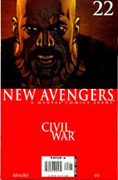 The New Avengers # 22 (Marvel Publishing) – What is Captain America’s deal? Why won’t he just sign up with the new Superhuman Registration Act and get on with life? Either a life of action has made the man incapable of explaining his point of view or, more likely, incompetent writing has made it difficult to puzzle out why the symbol of Marvel superhero-dom has become not just a refuse-nik, but an outlaw of the first degree. Perhaps the writers realized they had failed to clearly delineate a believable reason to refuse, beyond the safety of friends and family. Or perhaps this was the plan from the beginning. In either case, Luke Cage, always a second tier character despite having his own title, makes it clear and in a manner that cannot be denied. Whether you are following the Civil War or not, along with Spiderman’s unmasking, this is a must have issue of this mega-series. – Elgin
The New Avengers # 22 (Marvel Publishing) – What is Captain America’s deal? Why won’t he just sign up with the new Superhuman Registration Act and get on with life? Either a life of action has made the man incapable of explaining his point of view or, more likely, incompetent writing has made it difficult to puzzle out why the symbol of Marvel superhero-dom has become not just a refuse-nik, but an outlaw of the first degree. Perhaps the writers realized they had failed to clearly delineate a believable reason to refuse, beyond the safety of friends and family. Or perhaps this was the plan from the beginning. In either case, Luke Cage, always a second tier character despite having his own title, makes it clear and in a manner that cannot be denied. Whether you are following the Civil War or not, along with Spiderman’s unmasking, this is a must have issue of this mega-series. – Elgin
RATING: 
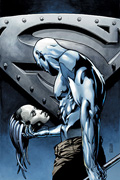 52 week fourteen (DC) – Some things are gelling better than other in 52. There are so many stories and plotlines floating around this series that one can forget about them only to be surprised (or disappointed) by their re-emergence. In this issue, Steel, transformed into a meta-metahuman by Luthor’s metagene drug, has a nervous breakdown since his niece rebelled against him. In Khandaq, Black Adam and Isis announce a marriage, while under their noses the Question and Renee Montoya track the source of Intergang’s new weapons. And in one of the surprisingly more interesting storylines, Will Magnus’s new mentor, T.O. Morrow, has disappeared from his prison cell, but left behind a gift, a gift which may see the resurrection of the Metal Men. Issue fourteen is one of the tighter, better plotted and paced issues, but still, with so much going on in 52, each battling for page space and attention, it all remains disjointed. –Graig–
52 week fourteen (DC) – Some things are gelling better than other in 52. There are so many stories and plotlines floating around this series that one can forget about them only to be surprised (or disappointed) by their re-emergence. In this issue, Steel, transformed into a meta-metahuman by Luthor’s metagene drug, has a nervous breakdown since his niece rebelled against him. In Khandaq, Black Adam and Isis announce a marriage, while under their noses the Question and Renee Montoya track the source of Intergang’s new weapons. And in one of the surprisingly more interesting storylines, Will Magnus’s new mentor, T.O. Morrow, has disappeared from his prison cell, but left behind a gift, a gift which may see the resurrection of the Metal Men. Issue fourteen is one of the tighter, better plotted and paced issues, but still, with so much going on in 52, each battling for page space and attention, it all remains disjointed. –Graig–
RATING: 
So ends this accounting of valiant warriors and high adventure! Return next week to honor still more comics. Praise Odin.
To discuss this column and all things Nordic, or if you have a comic you want to submit for review, contact Sean at scfahey@yahoo.com.